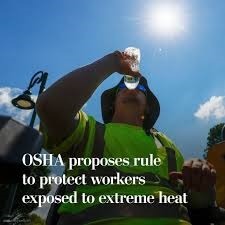
7.5.24 – Washington Post
The Occupational Safety and Health Administration proposed a rule Tuesday outlining steps employers must take to protect indoor and outdoor workers from the risk of heat illness, the first major regulation aimed at preventing heat-related deaths on the job.
The rule, if finalized, could add protections for 35 million workers nationwide. But it will face opposition from industry groups and major hurdles beyond that, including the possibility that Donald Trump could win a second term and block the rule from becoming final.
“The purpose of this rule is simple. It is to significantly reduce the number of work-related deaths, injuries and illnesses suffered by workers who are exposed to excessive heat and exposed to these risks while simply doing their jobs,” a senior administration official said on a call with reporters. “Whether they are making deliveries, carrying mail all day, working construction, picking vegetables, repairing power lines, doing landscaping. It’s these things that put workers at risk.”
OSHA officials have been working on the proposed regulation for more than two years at the urging of public health and climate advocates.
The proposal comes as summertime heat envelops the United States and the hottest month of the year gets underway. At the beginning of this week, over 60 million Americans were under heat alerts.
Excessive-heat warnings now cover much of California, including in and around San Francisco, and the National Weather Service office that serves much of California’s Central Valley warned of a “dangerous, prolonged heat wave that will last several days.” Southeastern states are also facing hot and soupy weather, and at least 45 million Americans will probably have to endure highs at or above 100 degrees this week.
Under the proposed rule issued Tuesday, OSHA would adopt two heat index thresholds that would apply nationally and would factor in humidity as well as temperature. One, at 80 degrees Fahrenheit, would require employers to provide drinking water and break areas that workers can use as needed. Employers would also need to have a plan for new and returning workers to gradually increase their workload so their bodies adjust to the heat.
More protections would kick in at 90 degrees, including monitoring for signs of heat illness and mandatory 15-minute rest breaks every two hours. Employers would be required to check on people working alone every few hours and to issue a hazard alert, reminding their workers of the importance of staying hydrated.
Juley Fulcher, a worker health advocate for the nonprofit Public Citizen, which has pushed for a national heat standard, said the proposal is based on scientific research on how the body responds to heat and borrows from state workplace heat safety laws. So far, only five states have such protections: California, Colorado, Minnesota, Oregon and Washington. Workers in Maryland could soon gain protections — there is a draft rule that is not yet final.
Fulcher praised the OSHA proposal, saying the agency had “done a really good job.” Although some Americans might balk at the suggestion they need protection from 80-degree weather, Fulcher said it’s important to remember that official temperature readings are taken in the shade. Once you factor in sunlight and humidity, an 80-degree day can feel more like 95 or 100, she said.
“If you’re doing really heavy work, you’re generating a lot of internal heat in addition to that external heat,” she said. “You’re not going to be able to cool off at those temperatures.”
The rule doesn’t cover everyone. “Sedentary” employees are exempt from the protections, as are those in indoor job sites kept below 80 degrees, emergency response workers and remote employees. And, because OSHA regulations do not extend to public employees, the regulation won’t apply to government workers and public school teachers, many of whom are confronting increasingly high temperatures in school buildings without air conditioning.
Some businesses and industry groups are gearing up for a battle over a regulation many see as burdensome, redundant and expensive.
The construction and home-building industries have asked for special treatment. In a letter to OSHA officials sent last week, the Construction Industry Safety Coalition — an organization that includes politically powerful groups like the Associated General Contractors of America and the National Association of Home Builders — wrote that “absent a withdrawal of the rulemaking in its entirety,” the agency should write a separate rule for construction workers.
“Construction work is simply too distinct from other general industries to be covered by the same rule,” the letter said, adding that construction sites are always changing, typically combine outdoor and indoor work and are often worked on by contractors who report to different employers.
Some industries have argued that they are already protecting employees from heat and that a new regulation would be duplicative or, worse, get in the way of what they’re doing. They have pushed back against the rule’s expected acclimatization requirements, which would mandate a gradual ramping-up of work hours during high heat. Some have questioned the entire initiative, saying that a workplace heat rule is unnecessary because not many workers die of heat exposure.
From 1992 to 2019, the Bureau of Labor Statistics found, there were an average of 32 heat-related workplace fatalities per year. There were 43 such deaths in 2022, up from 36 in 2021.
Agency officials and public health advocates say these numbers underestimate the scale of the problem, given underreporting and the difficulty of attributing a death to heat. Workplace data aside, deaths from heat in the United States have steadily increased in recent years, exceeding 2,200 last year.
